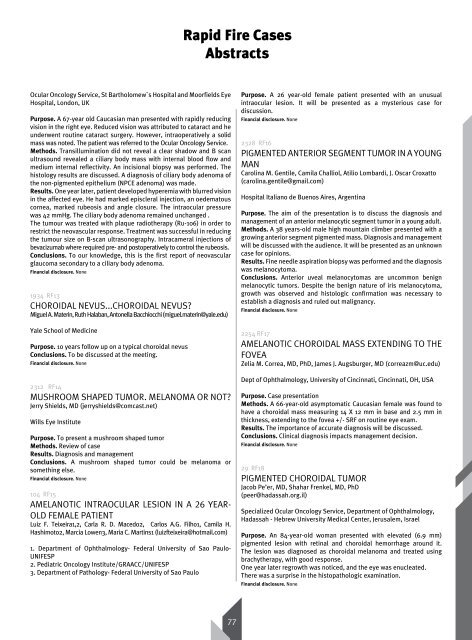Program Book
Program Book
Program Book
You also want an ePaper? Increase the reach of your titles
YUMPU automatically turns print PDFs into web optimized ePapers that Google loves.
Ocular Oncology Service, St Bartholomew`s Hospital and Moorfields Eye<br />
Hospital, London, UK<br />
Purpose. A 67-year old Caucasian man presented with rapidly reducing<br />
vision in the right eye. Reduced vision was attributed to cataract and he<br />
underwent routine cataract surgery. However, intraoperatively a solid<br />
mass was noted. The patient was referred to the Ocular Oncology Service.<br />
Methods. Transillumination did not reveal a clear shadow and B scan<br />
ultrasound revealed a ciliary body mass with internal blood flow and<br />
medium internal reflectivity. An incisional biopsy was performed. The<br />
histology results are discussed. A diagnosis of ciliary body adenoma of<br />
the non-pigmented epithelium (NPCE adenoma) was made.<br />
Results. One year later, patient developed hyperemia with blurred vision<br />
in the affected eye. He had marked episcleral injection, an oedematous<br />
cornea, marked rubeosis and angle closure. The intraocular pressure<br />
was 42 mmHg. The ciliary body adenoma remained unchanged .<br />
The tumour was treated with plaque radiotherapy (Ru-106) in order to<br />
restrict the neovascular response. Treatment was successful in reducing<br />
the tumour size on B-scan ultrasonography. Intracameral injections of<br />
bevacizumab where required pre- and postoperatively to control the rubeosis.<br />
Conclusions. To our knowledge, this is the first report of neovascular<br />
glaucoma secondary to a ciliary body adenoma.<br />
Financial disclosure. None<br />
1934 RF13<br />
CHOROIDAL NEVUS...CHOROIDAL NEVUS?<br />
Miguel A. Materin, Ruth Halaban, Antonella Bacchiocchi (miguel.materin@yale.edu)<br />
Yale School of Medicine<br />
Purpose. 10 years follow up on a typical choroidal nevus<br />
Conclusions. To be discussed at the meeting.<br />
Financial disclosure. None<br />
2312 RF14<br />
MUSHROOM SHAPED TUMOR. MELANOMA OR NOT?<br />
Jerry Shields, MD (jerryshields@comcast.net)<br />
Wills Eye Institute<br />
Purpose. To present a mushroom shaped tumor<br />
Methods. Review of case<br />
Results. Diagnosis and management<br />
Conclusions. A mushroom shaped tumor could be melanoma or<br />
something else.<br />
Financial disclosure. None<br />
104 RF15<br />
AMELANOTIC INTRAOCULAR LESION IN A 26 YEAR-<br />
OLD FEMALE PATIENT<br />
Luiz F. Teixeira1,2, Carla R. D. Macedo2, Carlos A.G. Filho1, Camila H.<br />
Hashimoto2, Marcia Lowen3, Maria C. Martins1 (luizfteixeira@hotmail.com)<br />
1. Department of Ophthalmology- Federal University of Sao Paulo-<br />
UNIFESP<br />
2. Pediatric Oncology Institute/GRAACC/UNIFESP<br />
3. Department of Pathology- Federal University of Sao Paulo<br />
Rapid Fire Cases<br />
Abstracts<br />
77<br />
Purpose. A 26 year-old female patient presented with an unusual<br />
intraocular lesion. It will be presented as a mysterious case for<br />
discussion.<br />
Financial disclosure. None<br />
2328 RF16<br />
PIGMENTED ANTERIOR SEGMENT TUMOR IN A YOUNG<br />
MAN<br />
Carolina M. Gentile, Camila Challiol, Atilio Lombardi, J. Oscar Croxatto<br />
(carolina.gentile@gmail.com)<br />
Hospital Italiano de Buenos Aires, Argentina<br />
Purpose. The aim of the presentation is to discuss the diagnosis and<br />
management of an anterior melanocytic segment tumor in a young adult.<br />
Methods. A 38 years-old male high mountain climber presented with a<br />
growing anterior segment pigmented mass. Diagnosis and management<br />
will be discussed with the audience. It will be presented as an unknown<br />
case for opinions.<br />
Results. Fine needle aspiration biopsy was performed and the diagnosis<br />
was melanocytoma.<br />
Conclusions. Anterior uveal melanocytomas are uncommon benign<br />
melanocytic tumors. Despite the benign nature of iris melanocytoma,<br />
growth was observed and histologic confirmation was necessary to<br />
establish a diagnosis and ruled out malignancy.<br />
Financial disclosure. None<br />
2254 RF17<br />
AMELANOTIC CHOROIDAL MASS EXTENDING TO THE<br />
FOVEA<br />
Zelia M. Correa, MD, PhD, James J. Augsburger, MD (correazm@uc.edu)<br />
Dept of Ophthalmology, University of Cincinnati, Cincinnati, OH, USA<br />
Purpose. Case presentation<br />
Methods. A 66-year-old asymptomatic Caucasian female was found to<br />
have a choroidal mass measuring 14 X 12 mm in base and 2.5 mm in<br />
thickness, extending to the fovea +/- SRF on routine eye exam.<br />
Results. The importance of accurate diagnosis will be discussed.<br />
Conclusions. Clinical diagnosis impacts management decision.<br />
Financial disclosure. None<br />
29 RF18<br />
PIGMENTED CHOROIDAL TUMOR<br />
Jacob Pe’er, MD, Shahar Frenkel, MD, PhD<br />
(peer@hadassah.org.il)<br />
Specialized Ocular Oncology Service, Department of Ophthalmology,<br />
Hadassah - Hebrew University Medical Center, Jerusalem, Israel<br />
Purpose. An 84-year-old woman presented with elevated (6.9 mm)<br />
pigmented lesion with retinal and choroidal hemorrhage around it.<br />
The lesion was diagnosed as choroidal melanoma and treated using<br />
brachytherapy, with good response.<br />
One year later regrowth was noticed, and the eye was enucleated.<br />
There was a surprise in the histopathologic examination.<br />
Financial disclosure. None


